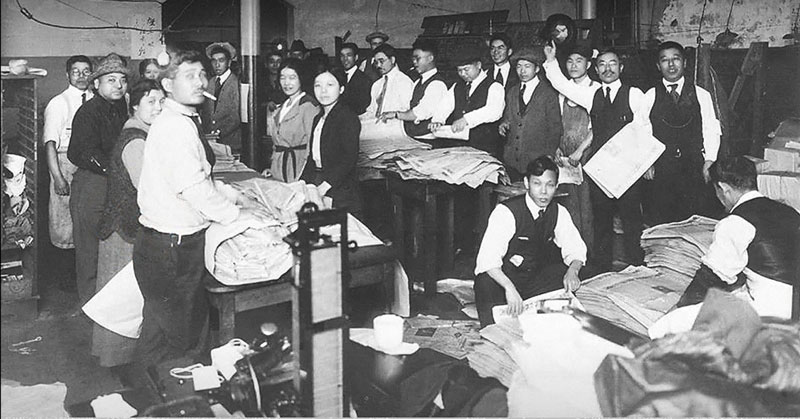By Kimiko Medlock
Japanese and Japanese American newspapers have been faithfully chronicling the history of the Japanese immigrant community since the late 1800s in the United States and Canada. Organizations such as “The Rafu Shimpo” (founded in Los Angeles in 1903), among many others, have gathered Japanese American stories and used them to create a sense of connection and to celebrate a shared heritage. “Paper Chase“ (2021, 54 min.), a new full-length documentary by the Zentoku Foundation, tells the story of how these vital, local news organizations rose and evolved since the late 1800s, and the challenges they face today in the age of digital and social media.
Ellen Endo, executive producer of “Paper Chase” and former managing editor of “The Rafu Shimpo,” explained that the film was inspired by a need to raise awareness about the vital role that Japanese American news media have played and continue to play in the Nikkei community.
“The early immigrants [from Japan] went in many different directions when they arrived in the United States. Some worked in farming, others were hired to build the railroads, and still others opened small businesses. Many immigrants ended up in Hawaii, the Pacific Northwest, California, and even Canada, and newspapers cropped up in each region. At first, the newspapers mostly published news of Japan. But later, they became a way to keep the community informed about things like where to get a job or an apartment, etc.”
These newspapers strove to highlight community stories that often did not make the mainstream press. Today, most of the remaining newspapers — “Hawaii Herald,” The Rafu Shimpo, “Chicago Shimpo,” North American Post, “Nikkei West,” “Nichi Bei Weekly” — are struggling for survival as readership and advertising have slowly declined.
“Paper Chase” treads the path of over 150 years of Japanese American history, telling the little-known story of the role this local media played in that history — creating connections and transmitting tradition across generations among a community that, especially in the early 1900s to post-WWII period, faced strong anti-Japanese discrimination and structural oppression. This rich history is what is at stake in Japanese American communities where the newspapers flourished for over a hundred years.
And the value of this history is personal. Endo herself currently serves as the Interim Chief Operating Officer of The Rafu Shimpo. In her interview with Discover Nikkei, she described how it was her “first real job.” She worked there for over 15 years through college and afterwards, before moving on to the ABC Television Network as a program executive on a new TV series. But she continued her relationship with the Rafu Shimpo over the years. Today she continues to write for the newspaper and serve as Interim COO in addition to running an independent consulting business. Over the course of her career, she had a front row seat to both the efforts of this media to bring value to the JA community, but also the declining readership, particularly with the rise of social media. This story is told through the words and experiences of numerous community leaders in JA media and experts in JA history — including editor Kenji Taguma of the Nichi Bei Weekly, Content Director of the Densho Project Brian Niiya, Senior Editor at the Rafu Shimpo Gwen Muranaka, and San Francisco State University Professor of Journalism Jon Funabiki, among many others.
When I asked Endo about the message of the movie, she emphasized that its purpose was to not to despair — but rather to inspire change and keep this tradition of vernacular Japanese media alive. What would she like to see?
“First, I want to see us embrace technology. By that, I mean we need to do more than simply put the newspapers online. Facebook and Instagram consistently post news items faster than the average newspaper, even if the newspaper is online. The time has come to recognize that social media is a traditional newspaper’s competition, and not just something that should be left to the younger generation. Second, I would like to see all of the Japanese American newspapers united under one umbrella, sharing content, and operating under a new business model. There are newspapers in the Pacific Northwest, Northern California, Southern California, Chicago, and Hawaii, and I think it’s safe to say that their biggest challenge today is survival.”
Kimiko Medlock is an occasional freelance writer currently living in the Bay area. She holds an MA in modern Japanese history.
Editor’s Note: This article was originally published in discovernikkei.org, a project of the Japanese American National Museum, Los Angeles.






